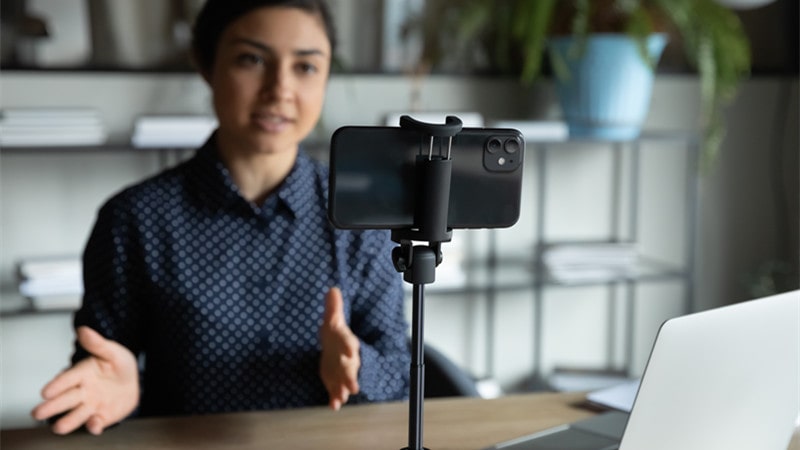Video is king in the digital landscape, from corporate meetings and webinars to product demos and social media snippets. Accurate transcription transforms spoken video content into priceless written text, enabling accessibility and SEO optimization. Live transcription enables real-time accessibility for students, employees and viewers with disabilities.
Learn how transcription can boost audience engagement, improve content repurposing and ensure all viewers can enjoy your video content.
Captions
For individuals who are deaf or hard of hearing, captions can be a game changer. Adding them to your video content opens up a new audience, demonstrating your commitment to inclusivity and making it accessible to everyone. Whether your video content is live or prerecorded, adding captions to your videos will help users engage with the audio and understand what’s being said.
Captions can be generated using automated tools that analyze audio and transcribe the words or manually written by human transcribers. Mechanical transcription services feature provides high accuracy for both prerecorded and live video, with the ability to create closed captions, translations, chaptering, and other types of textual enhancements. Adding transcripts to your video content makes it searchable by the major Internet search engines, boosting SEO and promoting visibility.
In addition to enhancing SEO, incorporating transcripts into your videos helps you reach a global audience. You can translate your transcripts into other languages by including keywords in the text, opening up a whole new world of potential viewers, with most of their videos featuring transcripts in several languages.
Transcripts
Video is a powerful tool that can drive conversions and improve SEO, but the spoken word is difficult for search engines to index and understand. Transcriptions, a video to text converter, will make it more accessible to many audiences. People who are d/Deaf or hard of hearing benefit from transcriptions, as do individuals with limited bandwidth or slow Internet connections.
For students, transcripts ensure they can continue learning even if their video is interrupted due to connectivity problems or classroom equipment malfunctions. Transcripts also empower marketers to capture insights that are difficult to express verbally in a video, such as customer concerns and preferences.
Many video conferencing apps have a built-in transcription option. This feature may not offer meeting insights, the option to take notes or other features that a full transcription service would provide. However, it can still be an effective accessibility solution.
Video editing programs have built-in captioning and transcription tools that can be used to create video files with subtitles that can be exported as burned-in or separate SRT files. These files can be added to existing videos or inserted into new videos as closed captions. Some dictation software can also transcribe videos and export them as text-based versions that can be embedded as subtitles within any video platform.
Descriptions
In addition to captions, audio descriptions can help viewers of video content who are blind or have vision loss. While audio transcripts talk through what’s being said on-screen, audio descriptions (AD) verbally describe the visual elements of your video — like a man in a suit standing by a cliff. They can be added to a standard video or a live-streamed video, and users can click on any words in the description to jump straight to that point within the video.
Using a professional human describer trained to focus on important visual information, audio descriptions help you comply with accessibility laws while offering your audiences more access and usability. This type of descriptive narration is usually played during natural pauses in the video, or you can edit your existing video to insert the AD track.
Even without disabilities, people rely on transcription to help them understand videos, save notes, or search for specific information in a video. In education, students preparing for exams or writing papers can use transcription to create written versions of their notes quickly.
Doctors and lawyers who record meetings or interviews can transcribe for quicker research. Market researchers who gather great swathes of data and need to be searched can also benefit from instant transcripts. And, of course, business leaders looking to boost SEO and reach more diverse audiences can also help with video transcribing.
Alt Text
Video transcription converts spoken audio to written text that can be used to create captions or subtitles for videos. This feature serves multiple purposes – workflow efficiency, accessibility, and search engine optimization (SEO). Video editors offer built-in transcription tools that make it easy to transcribe content as it is recorded automatically.
Video transcripts can also be translated into other languages, expanding the reach of a video’s content. This is a big benefit for international audiences who may not be fluent in English. Adding captions in their preferred language can help them better understand and engage with a video’s content.
In addition to making a video more accessible, transcripts provide context and supplemental information that can be helpful for viewers with limited or no vision. This is particularly true for visual content, such as graphs and charts, which can be difficult to interpret without a description. Alt text helps video viewers get the most out of its graphics by describing the image, providing its title, and highlighting important features.
In a digital world where online video has become the standard way to share information, boost engagement and conversion, improve SEO, and expand reach, it’s crucial that all users can easily access and fully consume the content you produce. Transcripts are essential for creating more accessible video content and ensuring that the largest audience hears your message.




